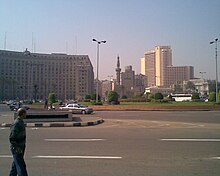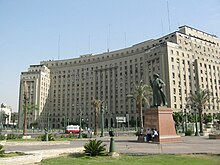Tahrir Square

Tahrir Square (Arabic: ميدان التحرير Mïdän at Taḥrǐr IPA: [meˈdæːn ettæħˈɾiːɾ], Inglis: Liberation Square) is a major public toun square in Cairo Ceety Centre, Egyp. The square wis oreeginally cawed Midan Ismaileyya (Inglis: Ismailia Square), efter the 19t-century ruler Khedive Ismail, who commissioned the new dountoun destrict's 'Paris on the Nile' design. Efter the Egyptian Revolution o 1919 the square became widely kent as Tahrir (Liberation) Square, but the square wis no offeecially renamed till the Egyptian Revolution o 1952, which chyngit Egyp frae a constitutional monarchy intae a republic.
Features
[eedit | eedit soorce]

At the centre o Tahrir Square is a lairge an busy traffic circle. On the north-east side is a plaza wi a statue o naitionalist hero Omar Makram, celebratit for his resistance against Napoleon I's invasion o Egyp, an ayont is the Omar Makram Mosque.[1]
The square is the northren terminus o the historic Qasr al-Ayni Street, the wastren terminus o Talaat Harb Street, an via Qasr al-Nil Street crossin its soothren portion it haes direct access tae the Qasr al-Nil Brig crossin the nearbi Nile River.
The aurie aroond Tahrir Square includes the Egyptian Museum, the Naitional Democratic Pairty-NDP heidquarters biggin, the Mogamma govrenment building, the Heidquarters o the Arab League biggin, the Nile Hotel, an the oreeginal dountoun campus o the American University in Cairo.
The Cairo Metro serves Tahrir Square wi the Sadat Station, which is the dountoun junction o the seestem's twa lines, linkin tae Giza, Maadi, Helwan, an ither destricts an suburbs o Greater Cairo. Its unnergrund access viaducts provide the safest routes for pedestrians crossin the broad roads o the hivily traffickt square.
Public uise an demonstrations
[eedit | eedit soorce]Tahrir Square haes been the traditional site for numerous major protests an demonstrations ower the years, includin the 1977 Egyptian Bread Riots, an the Mairch 2003 protest against the War in Iraq.[2]
2011 Egyptian Revolution
[eedit | eedit soorce]
Tahrir Square wis the focal pynt o the Egyptian Revolution o 2011 against umwhile preses Hosni Mubarak.[3] Ower 50,000 protesters first occupee'd the square on 25 Januar, durin which the aurie's wireless services wur reportit tae be impaired.[4] In the follaein days Tahrir Square continued tae be the primary destination for protests in Cairo.[5] On 29 Januar Egyptian fechter aircraft flew law ower the fowk gathered in the square. On 30 Januar, the seivent day o the protests, BBC an ither correspondents reportit that the nummer o demonstrators haed grown tae at least 100,000,[6] an on 31 Januar Al Jazeera correspondents reportit that the demonstrations haed grown tae at least 250,000 fowk.[7] On 1 Februar, Al Jazeera reportit that mair nor 1 million protesters peacefully gathered in the square an adjacent streets.[8]
The square became established as a focal pynt an a seembol for the ongoin Egyptian democracy demonstrations. On 2 Februar violence eruptit atween the pro-Mubarak an pro-democracy demonstrators here, follaed bi the 3 Februar 'Friday o Depairtur' demonstration, ane o the named "day o" events centred in the square. Athin a week, due tae internaitional media coverage, the image an name o Tahrir Square became kent warldwide.[9]
A Facebook page cried "Tahrir Square" ميدان التحرير wis maintained bi a rotatin staff o twinty durin the uprisin, pairticularly tae affset the lack o an/or distortit coverage o events an responses in the state-run media ootlets.[10][11]
The 18-day revolt centred in the square — led bi the young fowk o Egyp an jynt bi ceetizens o aw ages, genders, an classes — succeedit in remuivin Mubarak frae pouer on Friday 11 Februar 2011, when the preses offeecially stepped doun frae office. The annooncement that Mubarak haed passed aw authority tae the Cooncil o the Airmed Forces, wis made bi langtime intelligence chief an new vice preses Omar Suleiman.[12][13] Tahrir Square eruptit in a nicht-lang celebration efter the twilicht annooncement, wit shouts sic as "Lift your heid up heich, you're Egyptian," "Iveryane who loves Egyp, come an rebuild Egyp," an ithers.[14] The next day Egyptian Cairen weemen an men came tae clean up the square, "they came an cleaned up efter their revolution," relayin 'projectiles' in the cobblestane pavin an remuivin aichteen day's worth o trash an graffiti.[14]
Post-revolution
[eedit | eedit soorce]Tahrir Square, wi 'democracy anniversary' celebrations an visits frae foreign dignitaries, continues tae be a seembol o the 2011 Egyptian Revolution.[15][16] Breetish Prime Meenister David Cameron, Catherine Ashton, the Heich Representative for Foreign Affairs an Security Policy o the European Union, Hillary Clinton, Secretar o State o the Unitit States, an John Kerry, Chairman o the American Senate Committee on Foreign Relations visitit Tahrir Square Efter the 2011 Egyptian Revolution.
References
[eedit | eedit soorce]- ↑ "Midan Al-Tahrir, Liberation Square". Tour Egypt.
- ↑ Hiel, Betsy (19 Juin 2005). "Egyptian reformers taking it to streets". Pittsburgh Tribune-Review. Archived frae the original on 15 Juin 2011. Retrieved 20 Apryle 2011.
- ↑ BBC News: Egypt protests: Anti-Mubarak demonstrators arrested, 26 January 2011. Accessed 2011.01.26.
- ↑ "Egyptians report poor communication services on Day of Anger". Almasry Alyoum. 25 Januar 2011. Archived frae the original on 30 Januar 2011. Retrieved 25 Januar 2011.
- ↑ BBC News: "Egypt protests: curfew defied in Cairo and other cities" 29 January 2011. Accessed 2011.01.29.
- ↑ BBC News: "Egypt protesters step up pressure on Hosni Mubarak" 31 January 2011. Accessed 2011.01.31.
- ↑ Al Jazeera News: Live blog 31/1 — Egypt protests Archived 2011-08-29 at the Wayback Machine, 31 January 2011. Accessed 2011.01.31.
- ↑ Al Jazeera News: Protesters flood Egypt streets, 1 February 2011. Accessed 2011.02.01.
- ↑ Al Jazeera News: "Battle of Tahrir Square" 03 February 2011 . Accessed 2011.02.03
- ↑ Fahim, Kareem and Mana El-Naggar; Liam Stack and Ed Ou contributed reporting, "Emotions of a Reluctant Hero Galvanize Protesters", The New York Times, February 8, 2011 (February 9, 2011 p. A14 NY ed.).
- ↑ tahrir square, Facebook page. Retrieved 2011-02-11.
- ↑ Kirkpatrick, David D. and Anthony Shadid from Cairo. Other reporting was contributed by Kareem Fahim, Liam Stack, Mona El-Naggar and Thanassis Cambanis from Cairo, and Alan Cowell from Paris, “Mubarak Steps Down, Ceding Power to Military” ,The New York Times, February 11, 2011.
- ↑ BBC News: "Egypt crisis: President Hosni Mubarak resigns as leader"; 12 February 2011; Accessed 2011.02.21.
- ↑ a b BBC News: "Ahdaf Soueif: Protesters reclaim the spirit of Egypt"; 13 February 2011; Accessed 2011.02.21.
- ↑ BBC News: "Thousands attend political rally in central Cairo"; 18 February 2011; Accessed 2011.02.21.
- ↑ BBC News: "David Cameron meets locals around Cairo's Tahrir Square"; 21 February 2011; Accessed 2011.02.21.
Freemit airtins
[eedit | eedit soorce]| Wikimedia Commons haes media relatit tae Tahrir Square. |
